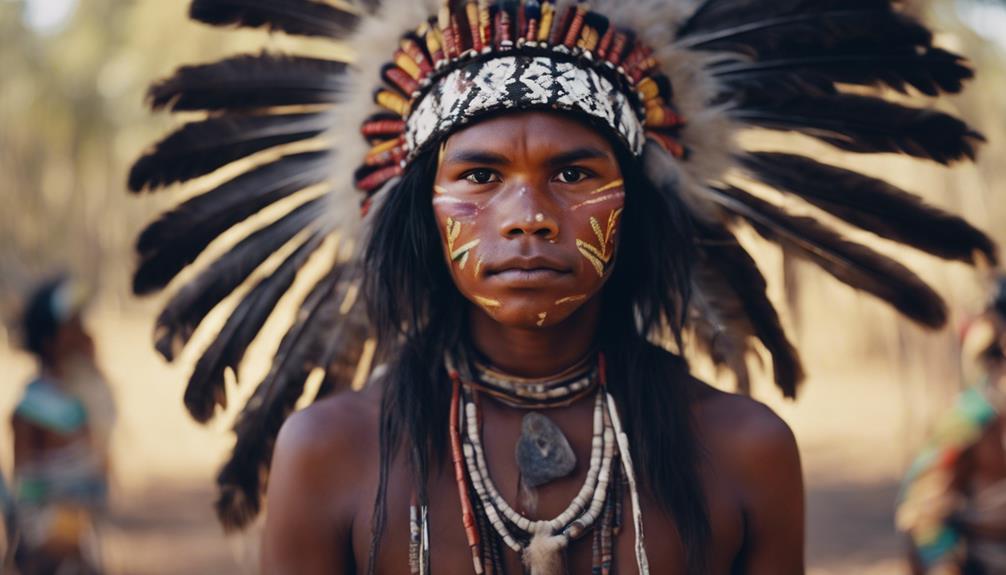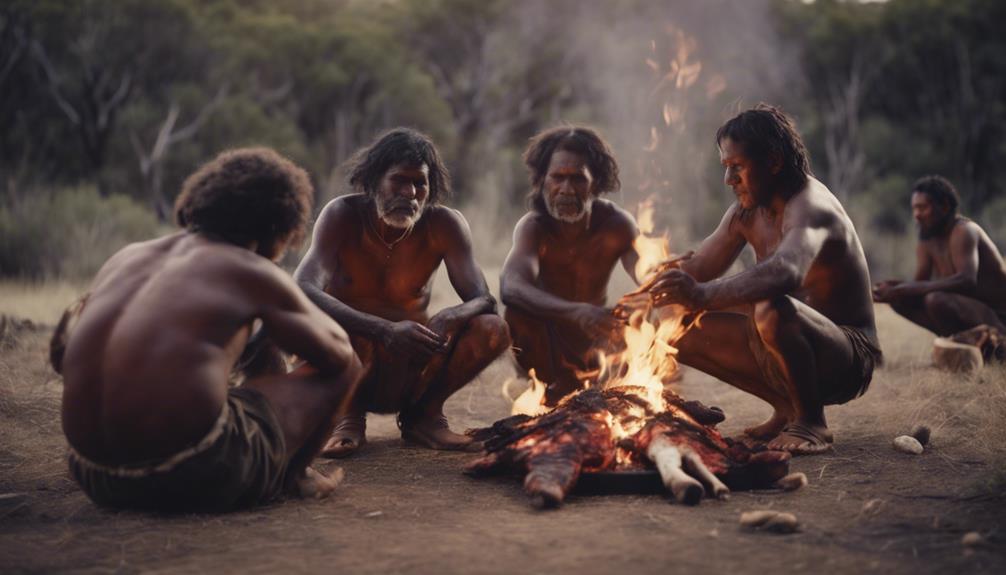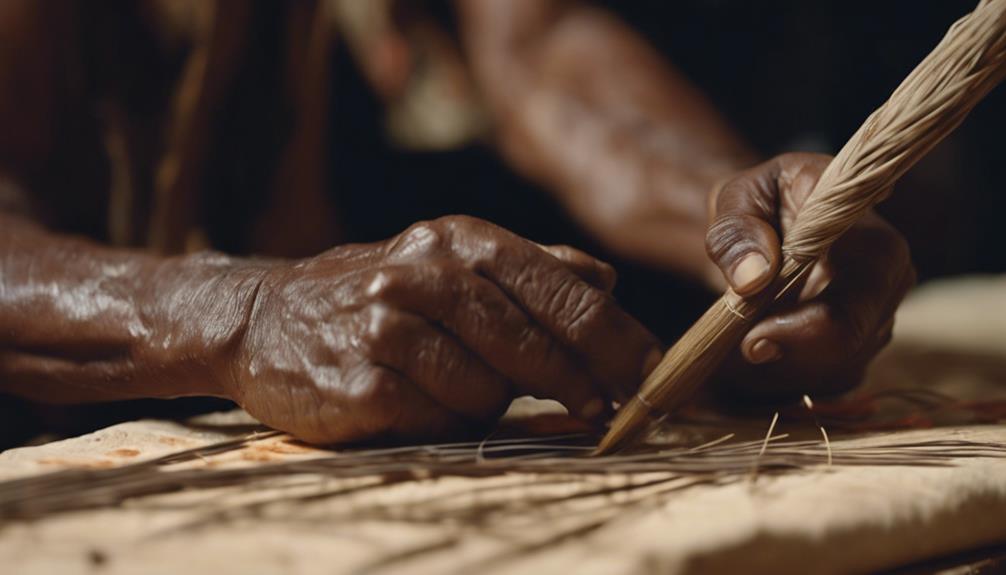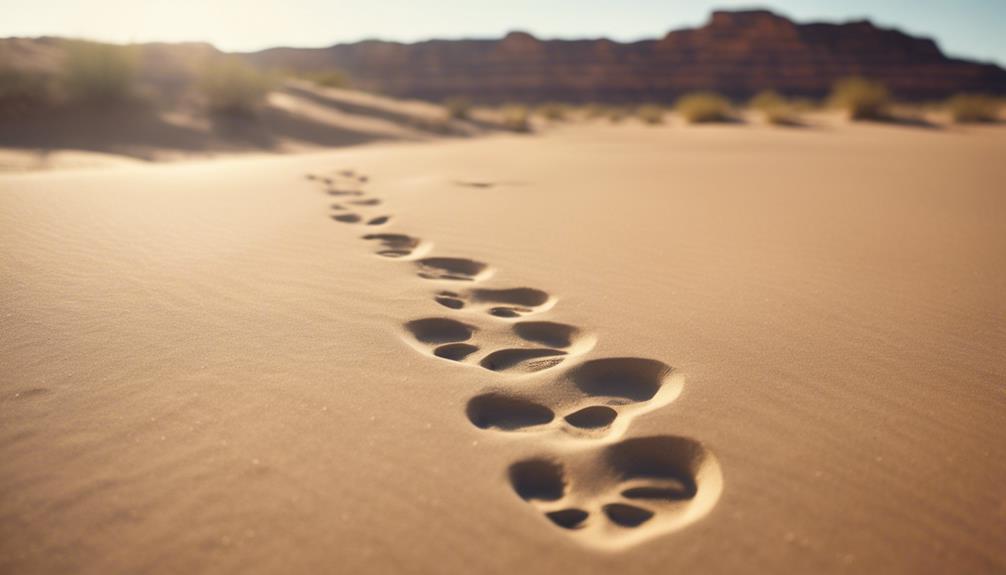
Have you ever wondered about the diverse ways emus have been utilized by Aboriginal communities for generations?
From sustenance to spiritual beliefs, these majestic birds have played a crucial role in the lives of Indigenous peoples.
Each aspect of the emu, from its meat to its feathers, holds significance beyond mere practicality.
Discover the intricate web of traditions and cultural practices that center around the emu, showcasing the deep connection between Aboriginal communities and the natural world.
Key Takeaways
- Emu meat's leanness and flavor valued in Aboriginal diets and traditions.
- Emu feathers and bones play vital roles in spiritual and cultural ceremonies.
- Emu products like oil and eggshells used for medicinal and artistic purposes.
- Traditional tools like Woomera reflect Aboriginal connection to land and heritage.
Emu Meat for Sustenance

Emus have long been prized by Aboriginal communities for their lean and flavorful meat, serving as a vital source of sustenance in traditional diets. Emu farming plays a significant role in maintaining the sustainability of this practice, ensuring a balance between harvesting and conservation. The process of emu hunting is deeply intertwined with cultural practices that have been passed down through generations, emphasizing respect for the animal and the land.
When it comes to emu farming, Aboriginal communities have embraced modern techniques while still preserving their traditional values. This approach not only sustains the population of emus but also supports the ecosystem in which they thrive. The act of hunting emus is more than just a means of acquiring food; it's a ritual that honors the connection between humans and nature.
Through the careful management of emu populations and the continuation of age-old hunting traditions, Aboriginal communities maintain a delicate balance that ensures the availability of emu meat for sustenance while respecting the natural world.
Emu Feathers in Ceremonies
In Aboriginal ceremonies, the exquisite feathers of the emu hold profound significance, symbolizing tradition and spiritual connections. Feather symbolism plays a vital role in these sacred traditions, with emu feathers often used in ceremonial rituals to honor ancestors and connect with the spiritual realm.
During ceremonies, the intricate patterns and soft textures of the emu feathers are admired for their beauty and revered for their cultural significance. They're carefully incorporated into headdresses, body adornments, and ceremonial objects, signifying respect for the land, ancestors, and the Dreamtime stories.
The act of adorning oneself with emu feathers is a deeply spiritual practice, symbolizing a connection to the natural world and the ancestral spirits. Each feather is a symbol of resilience, strength, and unity within the community. As the feathers sway gently in the wind during ceremonies, they carry prayers and blessings, creating a profound sense of harmony and reverence among participants.
Emu Bones for Tools

Utilizing the sturdy bones of the emu, Aboriginal communities craft essential tools that serve various practical purposes in their daily lives. The process of creating bone tools involves intricate craftsmanship and a deep understanding of the emu's skeletal structure. Emu bones are known for their strength and durability, making them ideal for tools that require resilience in harsh conditions.
These bone tools hold immense cultural significance within Aboriginal communities. Each tool isn't just a utilitarian object but a symbol of tradition and connection to the land. The crafting of these tools often involves ceremonies and rituals that pass down knowledge from generation to generation, reinforcing the importance of respecting and utilizing every part of the emu.
From sharp bone knives for cutting and carving to sturdy bone awls for sewing and crafting, these tools play a vital role in various aspects of daily life. The intricate designs and careful construction of each tool reflect the deep cultural heritage and practical wisdom of the Aboriginal peoples.
Emu Oil for Medicinal Purposes
Crafted by skilled artisans in Aboriginal communities, emu oil holds a revered place for its traditional medicinal uses among various indigenous cultures. Emu oil, extracted from the fat of the emu bird, is treasured for its numerous benefits. Renowned for its anti-inflammatory properties, emu oil is often used to alleviate joint pain, muscle aches, and skin conditions like eczema and psoriasis. Its deep moisturizing capabilities make it a popular choice for promoting healthy skin and reducing the appearance of scars and wrinkles.
The production techniques of emu oil involve rendering the fat of the emu bird through a process of heating and filtering to obtain a pure, high-quality oil. This oil is then carefully preserved to maintain its potent medicinal properties. Many traditional healers continue to use emu oil in their practices, passing down the knowledge of its benefits through generations. As modern research catches up with these age-old practices, the efficacy of emu oil for various medicinal purposes is increasingly being recognized and embraced.
Emu Eggshells in Artwork

Emu eggshells, intricate and delicate, serve as captivating canvases for Aboriginal artists to showcase their cultural heritage and artistic talents. When it comes to Emu eggshells in artwork, Aboriginal artisans display remarkable skill and creativity. They transform these fragile shells into stunning pieces of jewelry and intricate paintings that reflect the rich traditions and stories of their people.
| Emu Eggshell Jewelry | Emu Eggshell Painting Techniques |
|---|---|
| – Necklaces | – Intricate dot painting |
| – Earrings | – Cross-hatching patterns |
| – Bracelets | – Dreamtime stories depicted |
| – Pendants | – Natural earth pigments used |
Emu eggshell jewelry, such as necklaces and earrings, are meticulously crafted to highlight the natural beauty of the shell. These pieces often feature traditional designs that hold deep cultural significance. In painting techniques, artists employ intricate dot painting and cross-hatching methods to create mesmerizing patterns. The artworks frequently depict Dreamtime stories and are colored using natural earth pigments, adding a sense of authenticity and connection to the land. The utilization of Emu eggshells in art not only showcases Aboriginal creativity but also preserves and honors their ancestral practices.
Emu Fat for Skincare
When considering skincare, the nourishing properties of Emu fat have been revered for their potential benefits to the skin. Emu fat, a cherished beauty secret in Aboriginal traditions, is known for its exceptional skincare benefits. Here are some reasons why Emu fat is a popular choice for skincare:
- Deep Hydration: Emu fat penetrates deeply into the skin, providing intense moisture.
- Rich in Antioxidants: The fat is packed with antioxidants that help fight free radicals and promote skin rejuvenation.
- Anti-Inflammatory: It has anti-inflammatory properties that can soothe and calm irritated skin.
- High in Omega Fatty Acids: Emu fat is rich in omega fatty acids, which are essential for maintaining healthy skin.
- Non-Comedogenic: Despite being moisturizing, Emu fat is non-comedogenic, meaning it won't clog pores.
Embrace the wisdom of Aboriginal traditions and consider incorporating Emu fat into your skincare routine for a natural and effective way to nourish your skin.
Emu Sinew for Crafting

Utilizing Emu sinew in traditional crafting techniques offers a unique and durable material for creating intricate designs. The sinew, extracted from the tendons of the Emu, is known for its strength and flexibility, making it ideal for various crafting purposes. In Aboriginal culture, sinew crafting techniques have been passed down through generations, with artisans using this material to create traditional tools such as fishing lines, nets, and even intricate patterns in woven items.
To truly appreciate the significance of Emu sinew in crafting, let's delve into the traditional emu tools that were meticulously crafted using this material:
| Traditional Emu Tools | Description | Purpose |
|---|---|---|
| Woomera | Spear-throwing tool | Aid in hunting |
| Coolamon | Wooden vessel | Carrying water, fruits, or nuts |
| Mulga Wood Boomerang | Hunting tool | Used for hunting and in ceremonies |
Emu sinew not only serves a functional purpose but also embodies the cultural heritage and craftsmanship of the Aboriginal people, showcasing their deep connection to the land and its resources.
Emu Calls in Dreamtime Stories
In the enchanting Dreamtime stories of the Aboriginal culture, the haunting calls of the Emu echo through the ancient narratives, weaving a tapestry of connection between the land, its creatures, and the people.
Emu symbolism in folklore and communication holds a significant place in these tales, symbolizing traits such as loyalty, wisdom, and protection. This majestic bird's call is believed to carry messages from the spirit world, guiding and warning those who listen with open hearts.
Emu conservation is crucial in preserving not only a species but a vital part of Aboriginal culture, highlighting the deep cultural significance these birds hold for Indigenous communities. The Emu's call in Dreamtime stories serves as a reminder of the interconnectedness between all living beings, urging respect for nature and the spirits that dwell within.
Emu Footprints in Tracking

Emu footprints intricately etch a story of passage across the landscape, revealing a trail of wisdom and history for skilled trackers to interpret. In tracking techniques passed down through generations, these footprints hold cultural significance beyond their physical presence. Each imprint in the earth is a chapter in the book of tracking, guiding the knowledgeable eye along the path of the emu.
The art of reading emu footprints is steeped in storytelling traditions, where the land becomes a canvas for tales of movement and survival. The depth of the print, the spacing between each step, and the direction taken all speak volumes to those attuned to the language of the tracks. It's a dance of observation and understanding, a communion with the land and its inhabitants.
As you follow the trail of emu footprints, you aren't merely tracking a bird; you're following in the footsteps of tradition, connecting with the past, and embracing a heritage rich in knowledge and respect for the natural world.
Emu Dance in Rituals
Stepping beyond the intricate trail of emu footprints, one witnesses the profound significance of the Emu Dance in traditional rituals, where movements echo stories of cultural reverence and spiritual connection. The Emu Dance holds deep symbolism within Aboriginal culture, embodying traditions passed down through generations. As you observe this sacred dance, you feel the energy and history flowing through each movement, connecting you to the spirit of the emu and the land.
- Emu Dance Symbolism: Each step, each sway, carries layers of meaning, symbolizing the harmony between nature and humanity.
- Cultural Connection: Through the dance, the community celebrates their heritage and strengthens bonds with their ancestors.
- Spiritual Resonance: The rhythmic motions invoke a sense of oneness with the universe, honoring the interconnectedness of all living beings.
- Narrative Expression: Every gesture tells a story, preserving ancient wisdom and honoring the teachings of elders.
- Healing Powers: The Emu Dance is believed to have healing properties, bringing balance and restoration to both body and soul.
Emu Symbolism in Art

Amidst the vibrant tapestry of Aboriginal artistic expression, the symbolism of emus emerges as a profound and captivating motif, weaving tales of cultural significance and spiritual depth. Emu symbolism in modern art often reflects themes of resilience, family, and harmony with nature. In literature, emus are portrayed as symbols of wisdom, protection, and navigation through life's challenges. The majestic bird's characteristics, such as loyalty and nurturing behavior, inspire artists and writers alike to incorporate these qualities into their creations.
To illustrate the diverse ways emus are depicted in contemporary Aboriginal art, consider the following table:
| Emu Symbolism in Modern Art | Emu Representation in Literature |
|---|---|
| Resilience and Strength | Symbol of Wisdom |
| Connection to Family | Sign of Protection |
| Harmony with Nature | Guidance through Challenges |
Through brushstrokes and words, the enduring spirit of the emu continues to shape narratives of identity, heritage, and the profound interconnectedness between the natural world and humanity.
Emu in Spiritual Beliefs
In what ways do traditional Aboriginal spiritual beliefs incorporate the significance of the emu? Emus hold deep spiritual connections and cultural significance for Aboriginal communities. The emu isn't merely a physical creature but a symbol of spiritual wisdom and guidance, revered for its qualities and behaviors. Here are some key points to consider:
- Emus are often seen as spiritual guides, representing the journey of life and the wisdom gained along the way.
- The emu's ability to navigate vast distances in the harsh Australian landscape is symbolic of resilience and strength in the face of adversity.
- In some Aboriginal cultures, the emu is believed to possess healing powers, both physically and spiritually.
- Emus are sometimes associated with creation stories, where they play a role in the shaping of the land and the universe.
- The emu's presence in rituals and ceremonies underscores its importance in connecting the physical world with the spiritual realm.
Through these spiritual connections, the emu continues to be a cherished and respected symbol in Aboriginal cultural beliefs.
Frequently Asked Questions
How Do Aboriginal Communities Traditionally Hunt and Prepare Emus for Consumption?
When hunting emus traditionally, Aboriginal communities would employ intricate techniques passed down through generations. Cooking methods involved roasting over an open flame or wrapping in leaves for a flavorful meal rich in cultural significance and community bonding.
Are There Any Specific Rituals or Ceremonies Associated With the Use of Emu Feathers in Aboriginal Culture?
In Aboriginal culture, emu feather symbolism holds deep cultural significance. Ritualistic uses and ceremonial practices surrounding emu feathers are rich with tradition and meaning, often tied to spiritual beliefs and ancestral connections.
How Are Emu Bones Traditionally Used in Crafting Tools and Weapons in Aboriginal Societies?
When crafting tools and weapons in Aboriginal societies, emu bones play a crucial role due to their strength and durability. These bones are expertly shaped and honed to create implements essential for hunting and survival.
Can You Provide Examples of Specific Medicinal Uses for Emu Oil in Traditional Aboriginal Medicine?
You won't believe the miraculous powers of emu oil in traditional Aboriginal medicine. It's not just a remedy; it's a sacred elixir passed down through generations, embodying healing traditions and cultural significance.
How Do Aboriginal Artists Incorporate Emu Eggshells Into Their Artwork and What Significance Do They Hold in These Pieces?
Incorporating emu eggshells into art, Aboriginal artists infuse pieces with deep symbolism. Emu feather symbolism adds layers of cultural significance, while the delicate artistry of eggshells honors traditions and stories passed down through generations.
Conclusion
In conclusion, the traditional Aboriginal uses of emus are rich and varied, showcasing the deep connection between these majestic birds and Indigenous cultures.
From using emu meat for sustenance to incorporating emu feathers in ceremonies, each aspect holds significance and importance.
Emus have played a vital role in Aboriginal life for generations, leaving a lasting impact that can still be felt today.
Their presence is truly as vast and enduring as the outback itself.




